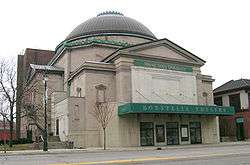Bonstelle Theatre
|
Temple Beth-El | |
 | |
| Location |
3424 Woodward Avenue Detroit, Michigan |
|---|---|
| Coordinates | 42°20′45.92″N 83°3′24.86″W / 42.3460889°N 83.0569056°WCoordinates: 42°20′45.92″N 83°3′24.86″W / 42.3460889°N 83.0569056°W |
| Built | 1902 |
| Architect | Albert Kahn; C. Howard Crane |
| Architectural style | Beaux-Arts |
| Part of | Midtown Woodward Historic District (#08001106) |
| MPS | Religious Structures of Woodward Ave. TR |
| NRHP Reference # | 82002911[1] |
| Significant dates | |
| Added to NRHP | August 3, 1982 |
| Designated CP | November 26, 2008 |
The Bonstelle Theatre is a theater operated by Wayne State University, and located at 3424 Woodward Avenue (the southeast corner of Woodward and Eliot) in the Midtown Woodward Historic District of Detroit, Michigan.[2] It was originally built in 1902 as the Temple Beth-El, and was listed on the National Register of Historic Places in 1982.[1]
Construction
When Rabbi Leo M. Franklin first began leading services at Detroit's Temple Beth El in 1899, he felt that the construction of a new temple building on Detroit's "Piety Row" stretch of Woodward would increase the visibility and prestige of Detroit's Jewish community.[2] Accordingly, in October 1900, the congregation held a special meeting at which it was decided to build a new temple.[3] A site for the new temple was purchased in April of the next year, and Albert Kahn, a member of the congregation, was hired to design the building.[3] Groundbreaking began on November 25, 1901, with the ceremonial cornerstone laid on April 23, 1902.[3] The first services were held in the chapel on January 24, 1903, and the formal dedication was held on September 18–19 of the same year.[3]
Building
The temple is a Beaux-Arts structure influenced primarily by Roman and Greek temples. Sobocinski cites the Pantheon in Rome for comparison. There is a prominent dome over the main area of the temple, with gabled wings on the north and south. A pedimented extension on the front once extended into a porch; the front section of the building was lost when Woodward was widened.[2]
Later use
When the Temple Beth El congregation built another building farther north along Woodward in 1922, they sold the building at Woodward and Eliot to Jessie Bonstelle for $500,000.[4] Bonstelle hired architect C. Howard Crane to convert the building into a theater, naming the resulting building the Bonstelle Playhouse.[4] In 1928, the Bonstelle Playhouse became the Detroit Civic Theatre, and in the 1930s became the Mayfair Motion Picture Theater. In 1951, Wayne State University rented the building as a performance space for its theater company, and purchased it outright in 1956, renaming it the Bonstelle Theatre in honor of Jessie Bonstelle.
Gallery
 Temple Beth El, c. 1905
Temple Beth El, c. 1905 Jessie Bonstelle in 1908
Jessie Bonstelle in 1908.jpg) Side view of the theater, with the name still showing on the back house brick
Side view of the theater, with the name still showing on the back house brick
See also
References
- 1 2 National Park Service (2007-01-23). "National Register Information System". National Register of Historic Places. National Park Service.
- 1 2 3 Temple Beth-El from Detroit 1701.org.
- 1 2 3 4 Katz, Irving I., The Beth El Story (with a History of Jews in Michigan Before 1850), Wayne State University Press, 1955, pp. 96-101.
- 1 2 Press release Archived September 1, 2006, at the Wayback Machine. from Wayne State University celebrating the 100th anniversary of the Bostelle Theatre.
Further reading
- Hill, Eric J. and John Gallagher (2002). AIA Detroit: The American Institute of Architects Guide to Detroit Architecture. Wayne State University Press. ISBN 0-8143-3120-3.
- Sobocinski, Melanie Grunow (2005). Detroit and Rome: building on the past. Regents of the University of Michigan. ISBN 0933691092.
External links
| Wikimedia Commons has media related to Bonstelle Theatre. |
- Bonstelle Theatre - Wayne State University
- Photographs from the Rabbi Leo M. Franklin archives: these include photographs c. 1903 - 1922 of both the interior and exterior of the structure.


